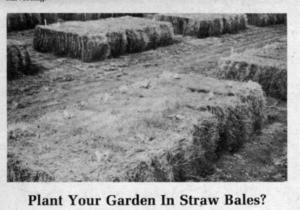1986 - Volume #10, Issue #4, Page #29
[ Sample Stories From This Issue | List of All Stories In This Issue | Print this story
| Read this issue]
Plant Your Garden In Straw Bales
 |
"It provides an alternative use for straw, other than burning, and lets you grow crops on land that couldn't otherwise be farmed," says Delbert Hemphill, crop scientist at the North Willamette Experiment Station, who envisions straw bales laid out in low lying boggy areas where other crops won't grow, in rocky fields, or along fence rows to make use of unused space.
Hemphill says it's also an idea that gardeners might want to take a look at since some crops do better in bales than they do in normal fertile ground,especially tomatoes. "We had the most success with tomatoes, cucumbers, muskmelon, and squash. We were less successful with cauliflower, cabbage, and peppers," he says.
Nitrogen, water and other nutrients must be added to the bale to be successful: Hemphill says fertilizers and micronutrients are simply applied to the surface of the bales. Water carries the nutrients into the root zone. Researchers added dolomite, lime, phosphate, and several other minor nutrients.
Contact: FARM SHOW Followup, Delbert Hemphill, North Willamette Experiment Station, 15210 N.E. Miley Rod., Aurora, Ore. 97002 (ph 503 678-1264).

Click here to download page story appeared in.

Click here to read entire issue
To read the rest of this story, download this issue below or click here to register with your account number.




